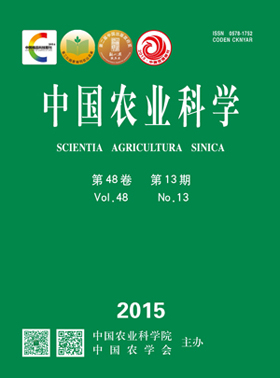-
Study on the Interspecies Crossbreeding Between Gayal (Bos frontalis) and Yellow Cattle(Bos taurus)
- HE Zhan-xing, WANG Peng-wu, LUO Zai-ren, LI Chun-mei, YIN Yi-chang, QU Kai-xing, WANG An-kui, ZHANG Ji-cai, HUANG Bi-zhi, YUAN Xi-ping
-
Scientia Agricultura Sinica. 2015, 48(13):
2676-2686.
doi:10.3864/j.issn.0578-1752.2015.13.019
-
 Abstract
(
628 )
Abstract
(
628 )
 HTML
(
4 )
HTML
(
4 )
 PDF (2358KB)
(
679
)
PDF (2358KB)
(
679
)
 Save
Save
-
References |
Related Articles |
Metrics
【Objective】To investigate the utilization and prospects in crossbreeding between the Gayal (Bos frontalis) and Yellow cattle (Bos taurus). 【Method】Interspecies crossbreeding were carried out on Yunnan yellow cattle(YY, n=379) and Simmental crossbred cattle (Simmental ♂× Yunnan yellow cattle ♀, SY, n=136) as the female parent inseminated artificially with frozen semen of Gayal. Pregnancy test of cow at about 60 days, number of calving were tracked, and body weight, body measurement, appearance characteristics of crossbred F1 were investigated. 【Result】Results were showed that: ① Rates of average conception and calving from 515 cows with frozen sperm of Gayal were 73.98% and 92.13%,thereinto rates of average conception and calving were 68.87% and 90.81% in YY, and 88.24% and 95% in SY, respectively. ②The body weights of crossbred F1 (Gayal × SY, MSY) at birth, 6-month, 12-month, 18-month and 24-month of age were 22.86, 103.86, 142.4, 176.21 and 243.25 kg, respectively, which were 94.89%, 26.01%, 31.04%, 41.42%, and 84.14% significantly higher than those of YY(P<0.01), and 29.15%(P<0.01), 1.63%(P>005), 5.63%(P>0.05), 9.16%(P<0.05) and 20.47%(P<0.01) higher than those of MY; Body weights of crossbred F1(Gayal × Yunnan yellow cattle, MY) at birth, 6-month, 12-month, 18-month and 24-month of age were in turn 17.7, 102.19, 134.81, 161.43 and 201.91 kg, which were 50.90%, 23.99%, 24.40%, 36.83% and 52.85% significantly higher than those of YY(P<0.01 or 0.05); Average daily gain(ADG) of MSY from birth to 24-month age was 301.90 g, which was significantly higher than that of MY (264.67 g) and YY (164.89 g) (P<0.01), and ADG of MY was also significantly higher than that of YY(P<0.01); heterosis rates of birth, 12-month and 24-month age of MY were 28.21%, 3.87% and 4.20%, respectively, especially heterosis of birth stage was the highest, which was more distinct than that of other age stage. ③Withers height and heart girth at birth were 59.09 and 60.09 cm in MSY and 60.78 and 59.15 cm in MY, which were significantly higher than those of YY(P<0.05); At 6 months of age, withers height, heart girth, abdomen girth and circumference of cannon bone of MSY were 106.47, 118.67, 125.18 and 13.66 cm, respectively, which were 25.88%, 16.50%, 9.81% and 29.48% higher than those of YY(P<0.05), and heart girth, abdomen girth and circumference of cannon bone of MY were 112.95, 126.65 and 12.79 cm, respectively, which were 10.89%, 11.10% and 21.23% higher than those of YY(P<0.05); At 12 months of age, body length, withers height, heart girth, abdomen girth and circumference of cannon bone of MSY were in turn 124.04, 125.00, 148.00, 165.08 and 14.60 cm, which were 33.82%(P<0.05), 30.64%(P<0.05), 31.16%(P<0.01), 29.95%(P<0.01) and 26.63%(P<0.05) higher than those of YY, and heart girth, abdomen girth and circumference of cannon bone of MY were 125.72, 143.98 and 14.05 cm, which were 11.41%(P<0.05), 13.34%(P<0.01) and 21.86%(P<0.05) higher than those of YY; body length, withers height, heart girth and abdomen girth of MSY were increase at 33.20%(P<0.05), 31.43%(P<0.05), 17.72%(P<0.01) and 14.65%(P<0.01) higher than those of MY; At 24 months of age, body length, height at withers, heart girth, abdomen girth and circumference of cannon bone of MSY were 147.00, 134.75, 163.50, 179.50 and 16.85 cm, respectively, which were 33.30% (P<0.01), 31.69% (P<0.01), 38.83%(P<0.01), 32.12% (P<0.01) and 41.60% (P<0.05) higher than those of YY; Heart girth, abdomen girth and circumference of cannon bone of MY were 144.49, 169.04 and 16.77, which were 22.69%(P<0.01), 24.42% (P<0.01) and 40.92% (P<0.05) higher than those of YY; Body length, height at withers and heart girth of MSY were increased at 38.72%, 27.83% and 13.16% higher than those of MY (P<0.01). It indicated crossbred F1 showed distinctly high on withers height and heart girth at birth, and distinctly advantages on heart grith, abdomen girth and circumference of cannon bone after 6 months of age, especially body length, withers height and heart girth of three-way crossing were more obvious growth than those of two-way crossing from the 12 months of age. ④Birth weight of crossbred F1 from Gayal and Dali yellow cattle was significantly higher than that of crossbred F1 from Gayal and Dehong yellow cattle, and various body measurements were not significantly difference between two crossbred F1. It indicated the effect of crossbreed was basically the same between Gayal × Dali yellow cattle and Gayal×Dehong yellow cattle. ⑤The mainly habit of adult crossbred F1 was highly the similar as Gayal. 【Conclusion】The results showed that interspecies hybridization of Gayal and Yunnan yellow cattle is viable, which put up good character such as fast growth, strong adaptability, distinct heterosis. Especially, heterosis of three-way crossing was better than that of two-way crossing; Crossbred F1 cow was fertile ability, but the crossbred F1 male was maybe infertile. Finally, interspecies hybridization of Gayal and Yunnan yellow cattle was good at utilization potentiality, popularization and application.









